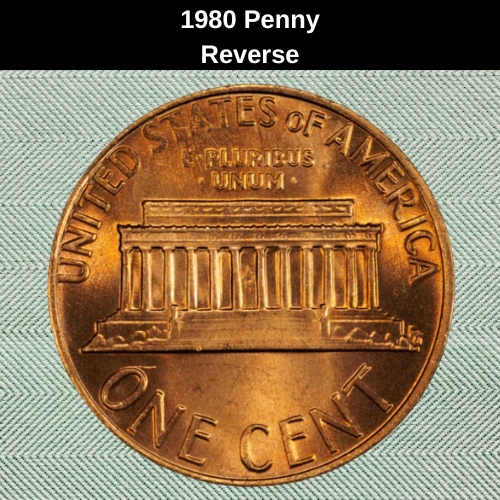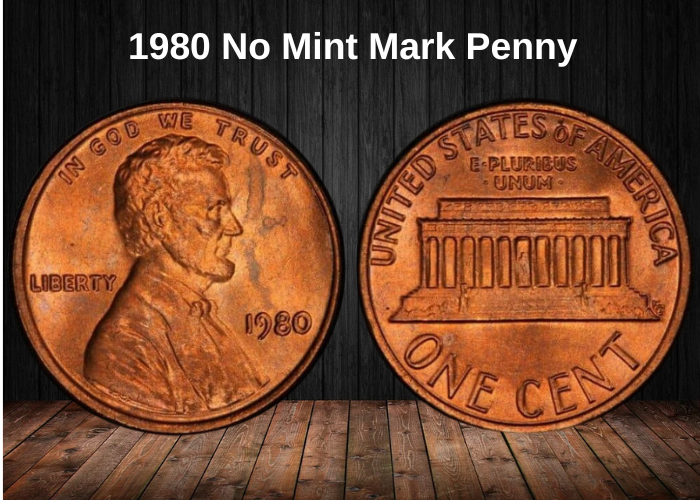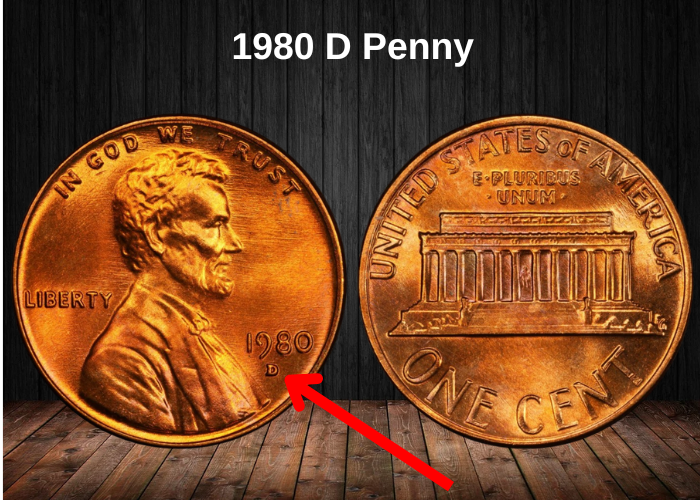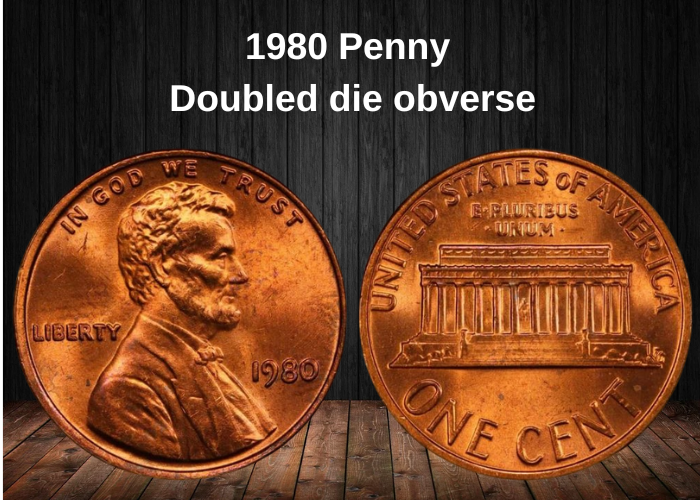In 1980, the Lincoln Memorial Cent was still composed of 95% copper and 5% zinc, a formula used since 1962. Three U.S. Mints produced pennies that year:
- Philadelphia: No mint mark (regular strike)
- Denver: “D” mint mark (regular strike)
- San Francisco: “S” mint mark (proof strike only)
The value of a 1980 penny depends heavily on its mint mark, condition, and especially whether it maintains its original red color (designated RD). High-grade coins, particularly in mint state (MS) or proof (PR), can be worth significantly more than face value.
1980 Penny Value Chart
| Condition | 1980 No Mint Mark Penny | 1980-D Penny | 1980-S Proof Penny |
|---|---|---|---|
| MS 65 RD | $15 | $15 | – |
| PR 65 RD | – | – | $3 |
🔍 Note: All values listed are for coins with Red (RD) designations. Red pennies are the most desirable among collectors.
History of the 1980 Penny

In 1909, America celebrated the 100th anniversary of Abraham Lincoln’s birth, and to honor the occasion, the U.S. Mint replaced the Indian Head cent with a new design featuring Lincoln’s portrait. This marked the first time a real historical figure—rather than a symbolic figure—was used on U.S. coinage intended for regular circulation.
Abraham Lincoln, the 16th President of the United States, is revered for his eloquence, political skill, and moral leadership. He is especially remembered for preserving the Union during the Civil War and paving the way toward the abolition of slavery. His legacy earned him a permanent place on America’s smallest and most widely used coin.
The original Lincoln cent design was created by Victor David Brenner, a respected sculptor and engraver. His portrait of Lincoln was so well-received that it remained unchanged on the obverse until today, making it one of the longest-running designs in U.S. coin history.
1959 Redesign: Lincoln Memorial Cent
In 1959, to commemorate the 150th anniversary of Lincoln’s birth, the U.S. Mint introduced a new reverse design. Frank Gasparro, the Mint’s Chief Engraver at the time, created the Lincoln Memorial reverse, which famously includes a tiny image of Lincoln’s statue inside the memorial. This design made the penny the first U.S. coin to depict the same person on both sides.
1980 Penny Types and Mintage
Here’s a breakdown of the 1980 Lincoln cent types and how many were minted at each location:
| Mint Location | 1980 Penny Type | Mintage |
|---|---|---|
| Philadelphia | No Mint Mark (regular) | 7,414,705,000 |
| Denver | “D” Mint Mark (regular) | 5,140,098,660 |
| San Francisco | “S” Mint Mark (Proof Only) | 3,554,806 |
| Total | – | 12,558,358,466 |
Later Design Changes
In 2009, the U.S. Mint released a series of four special reverse designs to celebrate Lincoln’s 200th birthday, each illustrating a different chapter of his life:
- Birth and Early Childhood – A log cabin in Kentucky
- Formative Years – A young Lincoln reading
- Professional Life – Lincoln as a lawyer in Illinois
- Presidency – The partially completed U.S. Capitol dome
The following year, in 2010, the penny’s reverse changed once again. It now features a Union Shield, symbolizing Lincoln’s role in preserving the United States as a single, unified nation. The shield was designed by artist Lyndall Bass and sculpted by Joseph Menna of the U.S. Mint.
Lincoln Cent Composition Timeline
- 1909–1982: 95% copper, 5% tin and zinc (except during WWII)
- 1943: Zinc-coated steel (wartime emergency issue)
- 1982–present: 97.5% zinc, 2.5% copper (copper-plated zinc)
Due to the rising price of copper, the U.S. Mint switched the penny’s composition in 1982. Both copper and zinc versions of the 1982 penny exist, making that year particularly interesting to collectors.
Features of the 1980 Penny
The obverse of the 1980 Penny

The obverse side of the 1980 Lincoln penny prominently features a right-facing portrait of President Abraham Lincoln, a design that has remained virtually unchanged since its introduction in 1909 by sculptor Victor David Brenner.
Lincoln’s profile occupies the center of the obverse. Above his head, along the upper rim, appears the national motto “IN GOD WE TRUST.” To the left, aligned with his neckline, is the word “LIBERTY.”
On the lower right, just in front of Lincoln’s chest, is the minting year “1980,” with the corresponding mint mark directly beneath it (if applicable). Below the truncation of Lincoln’s shoulder, you’ll find the designer’s initials, “VDB,” a subtle tribute to Brenner’s contribution to American coinage.
The reverse of the 1980 Penny

The reverse side of the 1980 Lincoln penny showcases the Lincoln Memorial, a design introduced in 1959 to replace the earlier Wheat Ears motif. Created by Frank Gasparro, this design honors President Abraham Lincoln by including his seated statue within the memorial—making it the first U.S. coin to feature the same individual on both sides.
At the top of the memorial appears the Latin motto “E PLURIBUS UNUM” (“Out of many, one”), symbolizing the unity of the states. Arched along the upper rim is the inscription “UNITED STATES OF AMERICA,” while the denomination “ONE CENT” is displayed prominently at the bottom. Gasparro’s initials, “FG,” are located near the lower right of the memorial base.
1980 Lincoln Penny Specifications
| Detail | Specification |
|---|---|
| Face Value | One Cent ($0.01) |
| Shape | Round |
| Composition | 95% Copper, 5% Zinc (or Tin) |
| Diameter | 0.750 inches (19.05 mm) |
| Thickness | 0.0598 inches (1.52 mm) |
| Weight | 0.1097 ounces (3.11 g) |
| Edge | Plain |
Additional Notes
The 1980 penny’s copper-based composition gives it a rich, reddish appearance. Over time, exposure to different conditions causes color variations ranging from bright red (RD) to reddish-brown (RB) and brown (BN). These tonal differences are also used in grading and affect the coin’s market value.
Let me know if you’d like to continue with information about values, grading, or notable error coins.
1980 Penny Grading Guide
Coin grading is the standardized process of assessing a coin’s condition, which directly influences its market value. For Lincoln pennies, grading considers several factors, including surface preservation, strike quality, luster, and the presence of any damage such as scratches, nicks, holes, or corrosion.
The most worn and damaged coins fall into the “Poor” category and typically hold no collector value. In contrast, uncirculated coins are more desirable and can range from Good (G) to About Uncirculated (AU), with Mint State (MS) coins being the most prized by collectors.
Below is the standard grading scale used for Lincoln cents, including the 1980 issue:
| Grade | Description |
|---|---|
| 1 | Basal State-1 (Heavily worn, barely identifiable) |
| 2 | Fair |
| 3 | Very Fair |
| 4, 5, 6 | Good |
| 7, 8, 10 | Very Good |
| 12, 15 | Fine |
| 20, 30 | Very Fine |
| 40 | Extremely Fine |
| 50 | About Uncirculated |
| 60 | Mint State (MS-60) |
| 65 | Mint State (MS-65, gem quality) |
| 70 | Mint State (MS-70, perfect coin) |
💡 Tip: Coins are also graded by color:
- RD (Red): Bright, original copper color
- RB (Red-Brown): Mix of red and brown tones
- BN (Brown): Fully brown from oxidation
For a precise valuation, it’s highly recommended to reference a professional grading guide or submit your coin to a certified grading service such as PCGS or NGC.
1980 Penny Value Guides
1980 No Mint Mark Penny Value

In 1980, the Philadelphia Mint struck approximately 7,414,705,000 Lincoln pennies without a mint mark. While most of these coins remain common, their value increases significantly with better condition and higher grades. Below is a general value guide for red (RD) examples graded by professional services:
- MS 63 – ~$5
- MS 64 – ~$10
- MS 65 – ~$15
- MS 66 – ~$40
- MS 67 – Starts at ~$300
Top Sale: A remarkable MS 67 RD specimen fetched $2,233 at Heritage Auctions in January 2017, reflecting its rarity and collector demand in top condition.
1980 D Penny Value

In 1980, the Denver Mint struck approximately 5,140,098,660 Lincoln cents with the “D” mint mark. While common in circulated grades, these coins can gain significant value in higher mint state (MS) conditions, especially when they exhibit a full red (RD) color.
Here’s a general guide to their market value:
- MS 63 RD – ~$4
- MS 64 RD – ~$10
- MS 65 RD – ~$15
- MS 66 RD – ~$42
- MS 67 RD – ~$140
Record Sale: An exceptional MS 67 RD 1980-D penny sold for $1,093 at Heritage Auctions in September 2007.
1980 S Penny Value (proof)

In 1980, the San Francisco Mint produced 3,554,806 proof Lincoln cents, all bearing the “S” mint mark. These coins were specially struck for collectors using polished dies and planchets, resulting in mirror-like surfaces and sharp details.
The value of these proof coins depends on their condition, particularly their numeric grade and cameo contrast:
- PR 69 DCAM – ~$15
- PR 70 DCAM – Up to $1,350
The highest premiums go to coins graded PR 70 Deep Cameo (DCAM), which show exceptional contrast between the frosted devices and mirrored fields.
Rare 1980 Penny Errors List
Doubled die obverse

The DDO (Doubled Die Obverse) error occurs due to a misalignment between the hub and the working die during the hubbing process. This results in visible doubling, typically seen on the obverse lettering (such as “LIBERTY” and “IN GOD WE TRUST”) and the date “1980”.
While the exact number of 1980 DDO Lincoln cents remains unknown, their scarcity and distinctive appearance make them valuable to collectors.
- A notable example:
- 1980 DDO Lincoln Penny, MS 65 – Sold for $715 at GreatCollections in 2014.
Tip: Always examine 1980 Lincoln cents carefully under magnification—doubled elements can significantly increase value.
1980 Lincoln Penny Error: Struck on a Dime Planchet
Occasionally during the minting process, a planchet intended for one denomination ends up in the wrong bin—typically due to a stuck blank slipping through a crack in a transport bin. When released, it mixes with other planchets and may get struck with a die from a different coin type.
That’s how a 1980 Lincoln cent was struck on a dime planchet at the Denver Mint. This error is easy to spot because the copper-nickel clad composition of dime blanks gives the penny a distinctive silver color.
Other notable features of this mint error include:
- Smaller diameter (17.91 mm vs. 19.05 mm for a regular cent)
- Lighter weight (2.3 g instead of 3.11 g)
- Reeded edge, which is typical for dimes but not for cents
1980 Lincoln Cent Overstruck on a Dime
This rare mint error results from a Lincoln cent being struck over an already-minted dime. The coin exhibits features from both denominations:
- On the obverse, you’ll see Lincoln’s profile and part of the word LIBERTY—superimposed over the reverse of the dime, including the denomination “ONE DIME”.
- Only the first two digits of the date (“19”) are visible, as the word “AMERICA” from the dime obscures the rest.
- The reverse is particularly fascinating: the Lincoln Memorial appears distorted over Roosevelt’s head. Most elements, including the mint mark, denomination, and date, are fragmented and jumbled.
These kinds of dramatic mint errors are highly prized by collectors and can command strong premiums depending on grade and visibility of the overstruck details.
Where to sell your penny?
Now that you know the value of your penny, you might be wondering where to sell it. Don’t worry: here’s a guide to some of the best online platforms where you can easily sell your coins, along with their advantages and disadvantages.
Discover the best platforms for selling coins online (pros and cons).
FAQ about the 1980 Penny
1. What is the composition of the 1980 penny, and why is this significant for collectors?
The 1980 Lincoln penny is made of 95% copper and 5% tin and zinc, weighing approximately 3.11 grams. This is significant because it’s part of the final years before the U.S. Mint transitioned to copper-plated zinc in mid-1982, making it one of the last full-copper issues. These coins are often more desirable to collectors for their higher intrinsic metal content.
2. Which mints struck the 1980 penny and how do their issues differ?
- Philadelphia (no mint mark): ~7.4 billion coins
- Denver (D): ~5.1 billion coins
- San Francisco (S): Only used for proof coins (~3.5 million)
Key differences:
- Denver coins often show slightly better strike quality.
- Philadelphia coins are known for potential minor doubling or weak strikes.
- San Francisco proof coins are struck with polished dies and show mirror fields with frosted designs.
3. Are there any notable varieties or errors in the 1980 penny series?
Yes, some notable varieties and errors include:
- Repunched Mint Marks (RPMs) on Denver coins
- Doubled dies, especially minor examples on the obverse
- Die cracks, cuds, and off-center strikes
While not extremely rare, certified and dramatic versions of these errors can sell for $25 to $200+, depending on grade and severity.
4. Why are “Red” (RD) 1980 pennies in high Mint State grades so desirable?
A full Red designation means that the coin has retained 95% or more of its original copper color. In Mint State grades like MS66 or MS67, these Red coins are scarce because copper tarnishes easily. A 1980 RD penny graded MS67 by PCGS or NGC can sell for $100 or more, depending on eye appeal and population reports.
5. What makes the 1980-S proof penny appealing to collectors?
The 1980-S proof was struck in San Francisco for collectors and features:
- Mirror-like fields
- Frosted devices (cameo contrast)
- Higher detail and polish than circulation coins
Examples graded PR69DCAM or PR70DCAM are especially valuable, often selling between $10 and $100+, depending on condition and certification.
6. How does the 1980 penny relate to broader economic and minting transitions in the U.S.?
The 1980 penny was minted during a time of rising inflation and metal cost pressures. The intrinsic value of copper was approaching or exceeding the coin’s face value, prompting the U.S. Mint to experiment with alternative compositions (like copper-plated zinc in 1982). Thus, the 1980 penny symbolizes the end of an era in U.S. small-denomination coinage.
7. Are there specific die characteristics or anomalies to look for in 1980 pennies?
Yes. Advanced collectors examine:
- Die polishing lines (common in proof and late die state coins)
- Die deterioration doubling (not true doubling, but a worn die effect)
- Minor doubled dies on LIBERTY or the date
- Cuds or die breaks from overused equipment
These features can make otherwise common coins more interesting or valuable in niche markets.


















































